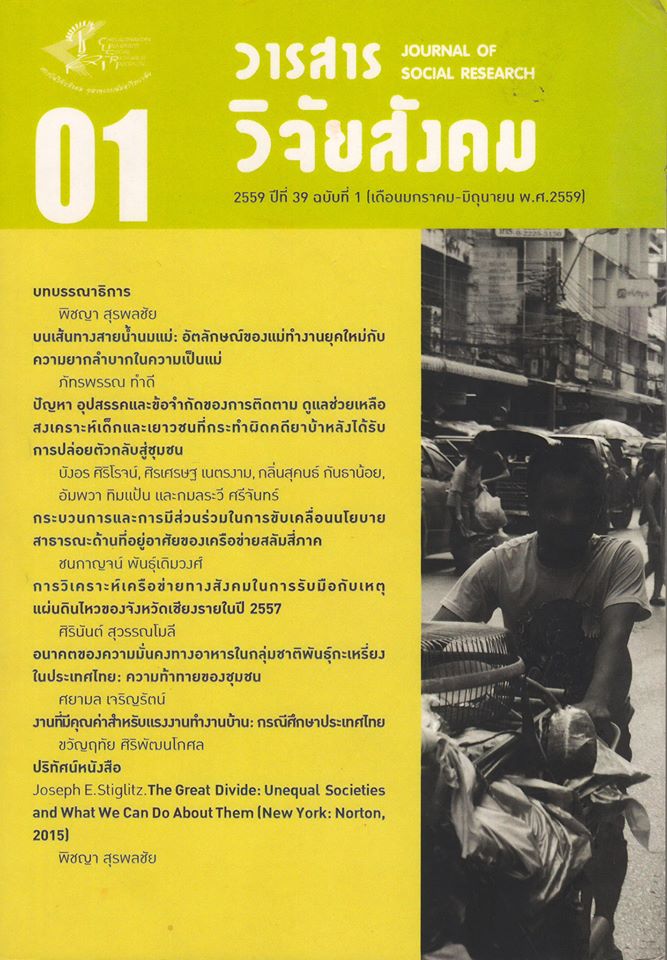การวิเคราะห์เครือข่ายทางสังคมในการรับมือกับเหตุแผ่นดินไหวของจังหวัดเชียงรายในปี 2557
Main Article Content
บทคัดย่อ
การวิจัยในครั้งนี้มีวัตถุประสงค์เพื่อ 1) ศึกษาสภาพปัญหาและอุปสรรคด้านนโยบายในการเตรียมพร้อมรับมือกับแผ่นดินไหวของจังหวัดเชียงรายตามแผนยุทธศาสตร์การป้องกันและบรรเทาสาธารณภัย 2) ศึกษาเครือข่ายทางสังคมในระดับท้องถิ่น ระดับจังหวัดและระดับชาติที่เกี่ยวข้องกับการเตรียมพร้อมรับมือกับแผ่นดินไหวของจังหวัดเชียงราย 3) ศึกษาแนวทางในการบูรณาการความร่วมมือระหว่างหน่วยงานที่สนับสนุนการลดผลกระทบจากเหตุแผ่นดินไหวของจังหวัดเชียงราย วิธีวิจัยจึงใช้การวิจัยแบบผสม โดยใช้การวิเคราะห์เครือข่ายทางสังคม (social network analysis) แสดงภาพความสัมพันธ์ของตัวแสดงทั้งภาครัฐ ภาคประชาชนและภาคประชาสังคมที่มีส่วนร่วมในการจัดการภัยผลการวิจัยจากข้อมูลเชิงคุณภาพพบว่า Topology ของเครือข่ายมีลักษณะผสมระหว่างดาว (star) กับต้นไม้ (tree) ความสัมพันธ์ส่วนใหญ่รวมศูนย์อยู่กับส่วนบัญชาการกลาง ในภาวะฉุกเฉินหน่วยงานระดับจังหวัดสามารถปฏิบัติงานได้ค่อนข้างพร้อมและเป็นเอกภาพ เพราะจังหวัดเชียงรายมีแผนปฏิบัติการรับมือแผ่นดินไหวที่ระบุบทบาทหน้าที่ของหน่วยงานต่างๆ ในระยะฉุกเฉินไว้ชัดเจนและเคยซ้อมไว้ก่อนเกิดภัยแล้ว แต่การฟื้นฟูในระยะถัดมากลับพบข้อจำกัด เนื่องจากการบริหารแบบรวมศูนย์กลาง ทำให้การส่งต่อข้อมูลมีหลายขั้น การฟื้นฟูจึงทำได้ล่าช้า ขณะที่การขาดระบบสารสนเทศสำหรับเชื่อมโยงฐานข้อมูลระหว่างหน่วยงานเข้าด้วยกัน ก็ทำให้ข้อมูลแต่ละหน่วยเก็บมาไม่ถูกใช้ร่วมกัน การแลกเปลี่ยนข้อมูลและแบ่งปันทรัพยากรก็เกิดขึ้นไม่เต็มที่ การประเมินความเสี่ยงสำหรับทำแผนเตรียมพร้อมป้องกันภัยเป็นองค์รวมจึงยังจำกัด นโยบายที่เหมาะสมกับการลดผลกระทบจากภัยพิบัติโดยการพัฒนาความร่วมมือระหว่างหน่วยงานจึงควรเริ่มจากการปรับปรุงการกระจายอำนาจ ให้ท้องถิ่นมีส่วนร่วมในการสะท้อนปัญหาในพื้นที่เพื่อปรับปรุงกระบวนการฟื้นฟูและพัฒนาศักยภาพชุมชนในการรับภัย การใช้เทคโนโลยีสารสนเทศมาสนับสนุนการแลกเปลี่ยนและการกระจายทรัพยากรให้เครือข่ายสามารถปรับเปลี่ยนรูปแบบได้อย่างยืดหยุ่นและปรับตัวจากแบบกระจายอำนาจออกจากส่วนกลางมาเป็นแบบกระจายได้เมื่อสถานการณ์คลี่คลาย
Social Network Analysis of Disaster Response in 2014 Chiangrai Province Earthquake
This study aims to 1) examine the problems and contexts in disaster management policy for the earthquake preparedness following the public disaster prevention and mitigation strategy plan 2) examine the social network in local, provincial and national levels which related to Chiangrai’s earthquake preparedness 3) examine the guideline for the inter-organizational integration in Chiangrai’s earthquake mitigation. The methodology of this study is mixed-method approach. The social network analysis is used to explore the relation among the disaster actors. The social network analysis is used to analyze the other relationship among the Government sector, people, and civil society in the affected area. It was found during the qualitative data analysis that the topology of the relation between the disaster management organizations is the mixed pattern of the star and the tree. Most relations were centralized to the central authority. During the emergency, the organizations at the province were united and ready to perform on duty cross jurisdiction, for Chiangrai Province’s organization had planned the roles and responsibilities of each organization and organized the rehearsal previously. However, the recovery phase faced some limitations. The management process was prolonged, and there was insufficient information system and the coordination between the mitigation organizations. These limitations slow down the recovery process. The cross-functioning action such as information or resource sharing could not be fully performed. Each unit collected their own data without sharing them together. There was also the limitation in the disaster risk-evaluation and the disaster management planning. The most suitable policy to decrease the impact of the earthquake should then start by developing the inter-organizational coordination. For example, the provincial’s disaster information must be shared. And the local level must be encouraged to utilize the information technology, resources allocation and thus increase the capacity to cope with the disaster. Finally, the pattern of relationship between each disaster management organizations should be flexible and adaptive from decentralize network to distribute network when the crisis is over.
Article Details
1) บทความนี้เป็นลิขสิทธิ์ของสถาบันวิจัยสังคม จุฬาลงกรณ์มหาวิทยาลัย แต่ความคิดเห็นและเนื้อหาเป็นของผู้แต่ง
2) ทัศนะและข้อคิดเห็นในวารสารวิจัยสังคมเป็นของผู้เขียนแต่ละท่าน มิใช่ทัศนะและข้อเขียนของกองบรรณาธิการฯ หรือสถาบันวิจัยสังคม จุฬาลงกรณ์มหาวิทยาลัย ผู้ประสงค์จะนำข้อความใดๆ ไปผลิต / เผยแพร่ซ้ำต้องได้รับอนุญาตจากผู้เขียนและกองบรรณาธิการวารสารวิจัยสังคม ว่าด้วยกฎหมายลิขสิทธิ์

